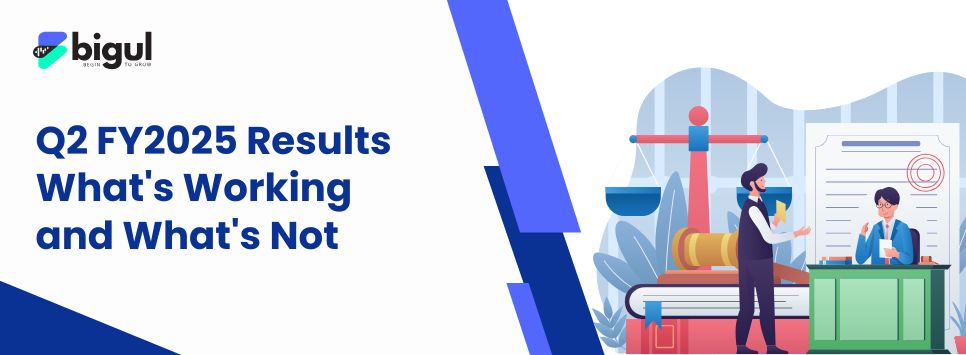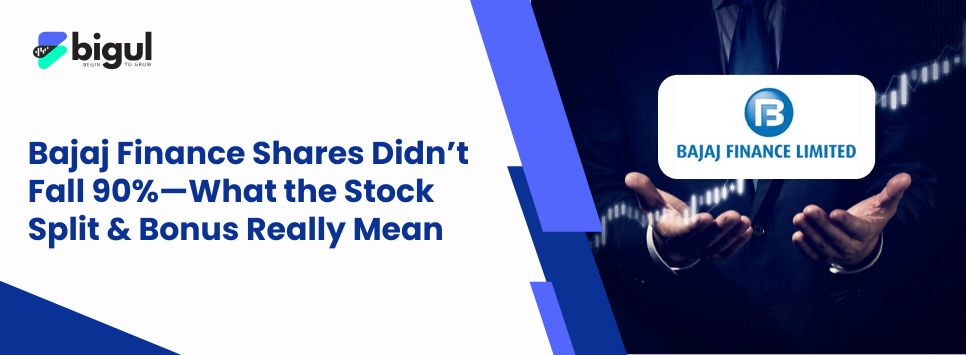Investors in Bajaj Finance were momentarily shocked on June 16, 2025, when their demat accounts showed a sharp 90% drop in holding value. However, this dramatic decline wasn't a market crash but simply the result of two corporate actions: a 4:1 bonus issue and a 1:2 stock split. Let's understand what this means for long term and short term investors of Bajaj Finance.
Understanding the Mechanics: Stock Splits and Bonus Issues Explained
Stock Split Fundamentals
A stock split is a corporate action when a company decides to multiply its shares to boost liquidity. In Bajaj Finance's case, the 1:2 stock split meant each existing share with a face value of Rs 2 was divided into two shares with a face value of Re 1 each. The total value of an investor's holding remains unchanged as the share price adjusts proportionally.
For example, if an investor-owned 100 shares priced at Rs 9,340 each before the split, they would own 200 shares priced at approximately Rs 4,670 each after the split. The mathematical equation remains constant: the total investment value stays the same initially.
Bonus Share Mechanics
Bonus shares are additional shares issued to existing shareholders at no extra cost, proportional to their current holdings. Bajaj Finance announced a 4:1 bonus issue, meaning shareholders receive four additional shares for every one share they hold. These bonus shares are typically issued from the company's retained earnings rather than being distributed as cash dividends.
Companies issue bonus shares for several strategic reasons: to capitalize retained earnings without affecting cash reserves, enhance stock liquidity in the market, and make shares more affordable to a broader range of investors.
The Mathematical Reality: How Your Investment Changes
Let's walk through a practical example to understand how Bajaj Finance's dual corporate action affected shareholders:
Starting Position: 1 share at Rs 9,340
Step 1 - Stock Split (1:2):
-
1 share becomes 2 shares
-
Price adjusts to Rs 4,670 per share
-
Total value: 2 × Rs 4,670 = Rs 9,340 (unchanged)
Step 2 - Bonus Issue (4:1):
-
For every 1 share held post-split, get 4 bonus shares
-
2 shares become 10 shares (2 + 8 bonus shares)
-
Price adjusts to Rs 934 per share
-
Total value: 10 × Rs 934 = Rs 9,340 (unchanged)
Final Outcome: Your total investment will remain the same but your 1 share will increase to 10.
What Will Be The Impact On Long Term And Short Term Investors Of Bajaj Finance?
For long-term investors, these corporate actions present several advantages. The increased number of shares provides greater flexibility for portfolio rebalancing and partial profit-booking without significantly impacting the overall position. Market experts believe the stock presents an attractive investment opportunity at current levels, with expectations that the NBFC space will move up by 15-20% in FY2025-26.
Its psychological effect cannot be under-emphasised either. Shares listed at a low price may seem more enticing to retail investors, and it may lead to a rise in their demand and liquidity.
Day Traders and Short-term Strategies
For active traders, corporate actions create both opportunities and challenges. Stock splits often lead to increased trading volume initially, with mega-cap securities experiencing significant spikes in volume the week immediately after the split. However, this effect typically declines over time.
Traders should be aware that volatility patterns change post-split. Volume-weighted implied volatility in large-cap securities tends to climb immediately following splits but tapers off in subsequent months. This creates specific windows for momentum-based trading strategies.
Margin Trading Considerations
Investors holding positions through Margin Trading Facility (MTF) face specific restrictions during corporate actions. Brokerages typically don't allow MTF positions to be held during bonus or split events, with positions usually required to be squared off by T-2 days before the record date. Investors wanting to benefit from corporate actions must convert their positions to delivery and hold shares in their demat accounts.
Strategic Implications for Bajaj Finance
Behind these corporate actions lies Bajaj Finance's robust financial performance. The company reported strong Q4 FY2025 results with total income of Rs 18,468.74 crores, representing a 23.69% year-on-year growth. Net profit reached Rs 4,479.57 crores, up 17.13% from the previous year.
The company's AUM grew more than 26% and rose to Rs 4,16,661Cr suggesting a strong business expansion. It showcases a strong support management confidence and strong revenue.
Long-Range Strategy and Growth Outlook
Bajaj Finance follows a strategic process called Long Range Strategy (LRS), a five-year rolling plan targeting a customer franchise of 190-210 million by FY2029. The company aims to scale its cross-sell franchise to 115-225 million over the same period, indicating substantial growth potential.
Under its LRS 2025-29, Bajaj Finance plans to work on 28 megatrends, including newly identified areas like Green Finance, where it aims to build a Rs 2,000 crore portfolio by FY2026.
Market Psychology and Behavioural Factors
"See, when a company does a stock split or issues bonus shares, it's like putting a pizza slice on two plates – you still have the same amount of pizza! But mom-and-pop investors often get all excited, seeing it as a positive sign. This excitement, especially because the lower price feels more affordable (even though the actual value per slice hasn't changed), can create a short-term buzz. More small investors jump in, pushing the price up temporarily.
Big professional investors, the institutions, usually just shrug. They focus on the company's real health, not this share-count shuffling. But hey, they're smart – they might trade knowing the small guys are likely to react. One side effect? If a lot more small investors own the stock, the company might notice fewer voices actively involved in big decisions, as retail owners tend to be less hands-on in governance stuff than the big funds."
Conclusion
Corporate action by Bajaj Finance reflects the surge of confidence by the management in the growth pattern of the company. It triggers a rise in the number of shareholders by offering more shares to retail investors. Its dramatic 90% crash was no more than a calculated technical change to indicate the increased number of shares.For investors, the key takeaway is that while the number of shares increases dramatically, the fundamental investment value remains unchanged initially.
This is the real advantage of increased liquidity, flexibility of trade and the possibility of entering an expanded market. To be successful in countering these corporate actions means, first, learning the mechanics, second, keeping in mind business fundamentals and, finally, learning how to determine the psychological forces behind rapid shifts in the market. Being either a long-term investor or active trader, such events provide an opportunity to those who know what to expect and what to do.









.jpg)
.jpg)
